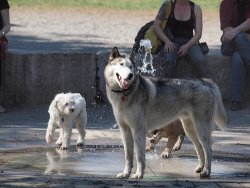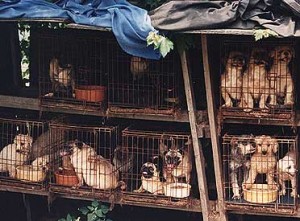Socializing Your Puppy or Dog
June 1, 2009 by LaBecs
Filed under Socializing Your Puppy or Dog
When you have a child, you have a responsibility to introduce him or her to a wide range of people and experiences to better prepare them for the world. The same is true when you have a puppy or a dog. This process is known as socialization. Let’s look at some of the reasons why this process is so important and how you can be sure to properly socialize your canine companion.
Good Reasons to Socialize
If you’ve seen aggressive dogs before, you’ve also seen the consequences of poor socialization. When dogs haven’t been introduced to these new experiences, they become fearful and anxious when encountering them. Just think of how you felt on the very first day you ever worked at a job or the first day you went to school.
Socialization, therefore, helps make dogs more comfortable when they have these experiences, such as meeting a new dog at the pet store or being petted by children or riding in the car. Positive early experiences are the best way to prevent future anxiety and aggression problems in your dog.
Another good thing about socialization is it helps you meet new people and have new experiences. Taking your dog to the park, for example, is a great way to start up conversations with people if you are normally a shy person.
Methods of Socialization
Obviously, the best time to start is when the puppy is very young. Take him or her with you whenever you can, and let people approach and pet him. Take him to the puppy education classes of your local pet shop where he will interact with other puppies. Take him to the small dog area of your local dog park. See how he reacts, how he acts, and get to know him well.
If you adopted an adult dog, hopefully he will have been exposed to other people and dogs in positive situations, but you still have to see for yourself how he reacts around people and animals.

The most important part of the socialization process is the positive experience. If you take your dog to the dog park for the first time and the experience is horrible, she is going to be more reluctant to return the second time. She may be fearful or anxious which could lead to another bad experience. Before you know it, the dog park is off limits. You obviously don’t want that to happen.
So, take her at a time when there are not a lot of dogs around. Don’t bring her in with the leash on. By now you should know how she reacts to other dogs she might have encountered on her walks. If she tends to be aggressive, you might need to do some training before exposing her to a large dog park. How can you guarantee a positive experience? Remove your own fear and nervousness about the situation. If you’re nervous, your dog will be, too. Always be positive and assume that the experience is going to go well.
Another way to do it is taking him to the pet shop, where she or he will probably encounter other dogs. When you go to the pet store, keep your dog on leash at all times (and do not use extensible leashes) and pay attention to his or her behavior. A dog that starts acting nervous or becomes very alert needs to be corrected immediately.
If your dog becomes nervous under certain circumstances, it’s a good idea to calmly make him or her confront what is causing the nervousness… unless it is a real threat. If you’re walking your dog on the sidewalk and a city bus drives by and startles your dog, the next time a bus comes, make him sit instead of letting him hide from it. Have him sit until the bus passes and then praise him like crazy. Now, if an unleashed, threatening dog were approaching you, this would require a different tactic and would not be the best time to confront the problem.
The important thing is to have your dog encounter as many new experiences and people as possible. Walk him or her in different locations: your neighborhood, the park, the river, around shopping areas that permit dogs, near roads, around noisy areas, and around quiet areas. You also want your dog to interact with other animals and people, including people of all types and ages. Make sure your dog is also socialized to lots of experiences, including riding in the car, having his feet touched, being groomed, getting a bath, being petted, and more.
The bottom line is that thorough socialization does take time and commitment from you, but the results are well worth the effort.
The Awful Reality of Puppy Mills
June 1, 2009 by LaBecs
Filed under The Awful Reality of Puppy Mills
You’ve probably heard about puppy mills. But did you know that if you purchase a dog from a pet store and many of the breeders online or in the newspaper, you could be helping keep the puppy mill industry afloat?
Most people don’t realize where those dogs who suffer so much end up. They often don’t even know how much suffering the dogs have to endure. Below is some information you should read before you decide how to find your new canine companion.
The Abuses of Puppy Mills
If you’re not familiar with the term “puppy mill”, you may want to learn about them before you start looking around for your new puppy or dog. Basically, puppy mills operate like factories to produce new offspring that can be sold.
Female dogs are bred from their first heat cycle and again each time until they are no long able to reproduce. Then they are “disposed of.” The puppies are kept with their mothers in tiny cages, usually stacked on top of one another in cramped and dirty environments. Because the cages are made from wire, the excrement and urine from the above dogs can fall down onto the lower dogs. The wire cages also cause foot injuries and are very uncomfortable.

A Living Hell
Most of the dogs are underfed. Most have worms because of their close quarters and their unhygienic environment. Fleas and mites are huge problems because most of these puppy mills are located in the country and none of them receive any type of preventative care. Some even contract heart worms and other serious illnesses. They also tend to have emotional problems because they lack any human contact during their formative years, and because their mothers are usually too weak to give them much compassion.
In some of the worst of these places, dead dogs are left in the cages to decompose with the living ones.
Where the Puppies Go
As you can imagine, most “hell operators”, as I like to call them, do not sell their “stock” from their factory. Instead, they have other ways of connecting with potential customers. Pet shops are one of the largest buyers. Most of the dogs you see being sold in pet stores for hundreds of dollars were bought for a fraction of that from puppy mills. However, since the puppy mills sell hundreds of dogs every couple of months, they are profiting from these sales in major ways.
But pet stores are only one method. Many of the breeders who advertise online and in the newspaper are also puppy mills themselves or are selling supplies of dogs they have gotten from puppy mills.
What you get is a puppy facing an array of immediate medical problems and with genetic diseases that will surface years later.
Signs of a Puppy Mill
Regardless of what pet stores may say, their supply of dogs comes from puppy mills. However, with breeders, you may have a harder time recognizing the possibilities. To protect yourself, always ask to visit the puppies on-site so you can view the condition of the mother and possibly the father. For obvious reasons, if you are buying directly from a puppy mill, they will have some excuse as to why you cannot do this.
If you do arrive on-site but are not allowed to see the mother of the puppies, this is also a sign the puppies may be from a puppy mill and that the mother may be another location altogether.
Never buy a puppy without seeing where they and their parents are raised and housed with your own eyes. Do your research; get references about breeders in your area.
While your heart may go out to these suffering puppies, when you buy them from these sources you’re only contributing to the problem and continuing the puppy mill business. That’s why I always urge and encourage people to adopt either from a humane society, a rescue, or a shelter, and help put those torture chambers out of business for good.
Control Your Dog’s Excited Urination
March 20, 2009 by LaBecs
Filed under Control Your Dog's Excited Urination
Who has not come across a dog that pees on cue as soon as you approach him or her to greet them? This is what is called submissive or excited urination
What is submissive or excited urination and why does it happen?
A submissive urinator is a dog that cannot help urinating in situations of extreme excitement or stress – he’ll go on the floor, on himself on you, on your furniture or on your guests!
Puppies are a perfect example of submissive urinators. They’ll pee whenever they’re excited to see you or when they meet a stranger. But sometimes very timid or sensitive adult dogs can have the problem too. It’s very typical of a dog that has been abused to exhibit this behavior.
This problem can happen in many situations:
-When they meet you after a prolonged absence
-When they’re playing
-When your guests arrive
-When there’s a stressful situation at home
-When you scold him or correct him
-Loud noises like a thunderstorm or fireworks
But don’t despair. It is really not difficult to fix this problem of submissive/excited urination.
First of all, take him to the veterinarian to make sure there’s no medical reason for the issue. Diabetes or a bladder infection can have the same effect.
Then you can follow some simple steps:
-Limit his intake of water. This doesn’t mean that you should restrict his water intake, but if, for example, you are expecting guests, or you will soon have a play session, take his water bowl away for a little while before the event happens.
-Don’t make your coming home a big event. When you come in the door, ignore him, go about your business and don’t get him worked up. The more excited he is, the harder it will be for him to control his bladder. I know I have a hard time not saying a warm hello to my baby, but you can always ignore him for the first few seconds and then crouch down and greet him calmly.
-Keep in mind the importance of NOT punishing or yelling at your dog when he has his “accident”. Remember he cannot control it and above all, he’s not doing it on purpose. When you catch him in the act, interrupt him with a firm “No!”, and praise him when he stops, but never punish him. Keep calm and be understanding: he doesn’t mean to do it.
-When he urinates out of fear (submissiveness) when you are scolding him for another reason, try to maintain an authoritative and firm tone, but don’t get angry. Keep in mind that in all probability, you are dealing with a sensitive, highly-strung dog, so, if you get angry or worry him further, the problem will definitely get worse.
-When the problem happens with loud noises like fireworks, if you show a reaction yourself and pet him for being scared, you will only be rewarding the behavior and training him to repeat it, and you don’t want that. You can try and make it a game. When you hear a loud bang, say, “what was that!” Make it a search game and give him a treat or a toy. You can also make no reaction whatsoever, or fuss or comfort him. Give him the down and stay commands, give him a treat and tell him he’s a good boy.
Always remember that when you have a dog, you must treat him with respect and understanding. Almost every “problem” has a solution, and with a little patience, you can do it without the need of expensive training. A few hours working on a problem, can give you many years of enjoyment with your best friend.


